The Coaches Room is a regular feature throughout the 2021-22 season by former NHL coaches and assistants who will turn their critical gaze to the game and explain it through the lens of a teacher. Rocky Thompson and Dave Barr will take turns providing insight.
In this edition, Thompson, who was an assistant with the Edmonton Oilers in 2014-15 and an associate coach with the San Jose Sharks in 2020-21, takes a close look at two Western Conference teams that are off to strong starts, the Edmonton Oilers and Calgary Flames.
Oilers, Flames use different styles to achieve success
Thompson says Edmonton relies on special teams, Calgary thrives at even strength

EDM@ARI: Draisaitl fights through checkers to score
CGY@BUF: Mangiapane finishes Tanev's dish in 2nd

















